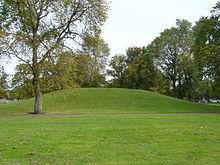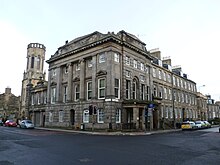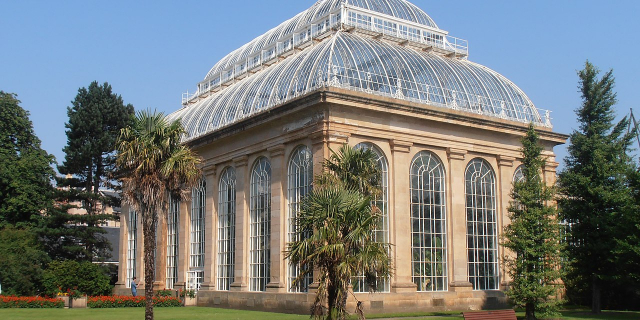Leith (; Scottish Gaelic: Lìte) is a port area in the north of Edinburgh, Scotland, founded at the mouth of the Water of Leith.
The earliest surviving historical references are in the royal charter authorising the construction of Holyrood Abbey in 1128 in which it is termed Inverlet (Inverleith). After centuries of control by Edinburgh, Leith was made a separate burgh in 1833 only to be merged into Edinburgh in 1920.
Leith is located on the southern coast of the Firth of Forth and lies within the City of Edinburgh council area; since 2007 it has formed one of 17 multi-member wards of the city.
 The Shore, Leith
The Shore, LeithAs the major port serving Edinburgh, Leith has seen many significant events in Scottish history.
First settlementThe earliest evidence of settlement in Leith comes from several archaeological digs undertaken in The Shore area in the late 20th century. Amongst the finds were medieval wharf edges from the 12th century. This date fits with the earliest documentary evidence of settlement in Leith, the foundation charter of Holyrood Abbey.
Mary of Guelders, the bride of James II, arrived on 18 May 1449 and rested in the Convent of St Anthony.[1] Prominent Leith merchants and shipowners included James Makysone, who supplied tapestry to James IV in 1498 for his new lodging at Stirling Castle and in 1503 imported a timber keel from France for building one of the king's ships.[2]
1500sThe town was burnt by the Earl of Hertford (on the orders of Henry VIII) in retaliation for the rejection of the Treaty of Greenwich by the Parliament of Scotland in 1543. Mary of Guise ruled Scotland from Leith in 1560 as Regent while her daughter, Mary, Queen of Scots remained in France. Mary of Guise moved the Scottish Court to Leith, to a site that is now Parliament Street, off Coalhill. According to the 18th-century historian William Maitland, her palace was situated on Rotten Row, now Water Street. Artifacts from the demolished residence are held by the National Museum of Scotland, and her sculptured coat of arms, dated 1560, can be seen in South Leith Parish Church. When the large French garrison stationed in Leith was attacked by Scottish Protestant lords, reinforced by troops and artillery sent from England, Mary of Guise was forced to shut herself in Edinburgh Castle. In June 1560, Mary of Guise died, and the Siege of Leith ended with the departure of the French troops in accordance with the Treaty of Leith, also known as the Treaty of Edinburgh.
 'Giant's Brae' on Leith Links
'Giant's Brae' on Leith LinksTwo mounds on Leith Links, known as "Giant's Brae" and "Lady Fyfe's Brae", identified as Somerset's Battery and Pelham's Battery respectively, are believed to be artillery mounds created for the siege in April 1560 and are listed as scheduled monuments, but may be natural hillocks.[3] The best documented day of the siege was 7 May 1560, when the English and Scots charged the walls of Leith with ladders that turned out to be too short. John Knox records the delight of Mary of Guise at the failure of the attack, and English sources report 1000 casualties.[4]
 Lamb's House in 2009
Lamb's House in 2009On 19 August 1561, Mary, Queen of Scots, arrived in Leith and, finding no welcoming party to receive her, made a brief stop at the house of Andrew Lamb, before being collected and escorted by coach to Holyrood Palace, to begin her ill-fated six-year-long reign.[5]
 Remains of the Citadel
Remains of the CitadelAfter the abdication of Mary Queen of Scots in 1567, during the ensuing civil war, troops fighting for James VI of Scotland against his mother's supporters in Edinburgh Castle based themselves in Leith from 1571 to 1573, a period called the "Wars between Leith and Edinburgh". In January 1581 The Shore was the scene of a mock combat, involving an assault on the Pope's Castel Sant'Angelo built on boats, for the marriage of Elizabeth Stuart, 2nd Countess of Moray and James Stewart for the entertainment of guests including James VI.[6] In 1590, James's wife, Anne of Denmark, was lodged in the King's Wark when she arrived.[7]
1600sIn 1622 there was conflict between privateer "Dunkirker ships" flying the Spanish flag and ships from the Dutch Republic.[8] King James allowed a Dunkirker to lie at Leith Roads in June 1622, and soldiers from the ship were able to come ashore at Leith. Three Dutch ships, commanded by Willem de Zoete, Lord of Hautain, Admiral of Zeeland, arrived and attacked the Dunkirker through the night. The fighting stopped in the morning when the tide beached the ships. The Scottish authorities requested the fighting stop. The ships were allowed into Leith harbour where artillery from Edinburgh Castle was placed to ensure order.[9]
Leith suffered during the 1645 plague outbreak, with over 50% of the population in the southern district dying. Archaeological excavations in 2016 at St Mary's RC Primary School, by Wardell Armstrong, as part of a planning condition, found a mass grave of 81 bodies from the 1645 plague. The archaeologists surmised that there was extreme fear of dying from this plague, likely Pneumonic, as many of the bodies were hastily buried in their clothes and still had money and other personal items on them, indicating that people did not want to touch the bodies, even to remove money.[10]
In 1650, Leith was a prospective battleground when the Army of the Covenant, led by General David Leslie, threw up an earthen rampart between Calton Hill and Leith to defend the northern approach to Edinburgh against Oliver Cromwell's forces. This rampart became the line of one of Edinburgh's longest streets, Leith Walk. After Cromwell's victory at the Battle of Dunbar in 1650 and subsequent occupation of Scotland, a fort known as Leith Citadel was erected in 1656 to regulate the port traffic. All that remains of the fort today is a vaulted trance in Dock Street which was its main entrance. New industry in Leith included the Leith Sugar House, founded in 1677.[11]
1700s Royal Artillery at Leith Fort, 1846
Royal Artillery at Leith Fort, 1846During the American War of Independence the Scot, John Paul Jones, who, with John Barry, is credited as founder of the US Navy, set sail on 14 August 1779 as commodore of a squadron of seven ships with the intention of destroying British commerce in the North Sea. He intended to capture the port of Leith and hold it for ransom, but his plan was thwarted when a gale on 16 September kept him at the mouth of the Firth of Forth. The scare he caused led to the hasty erection of Leith Fort, with a battery of nine guns, designed by James Craig, the architect of Edinburgh's New Town, and built in 1780. A Georgian terrace to the north-east served as officers' quarters, and was known as "London Row" because, being brick-built, it looked more like a London terrace than any in Edinburgh. The fort was in active use until 1955, latterly serving for National Service training. Most of the barracks were demolished to build a Council housing scheme centred on Fort House and enclosed by the old fort walls. The Council development was an award-winning scheme in its day (1955), but the building was demolished in January 2013 and the site has been redeveloped with new low-density housing, again award-winning. A pair of the old fort's gatehouses survive at the southern entrance to the scheme.
From the twelfth century South Leith was part of the parish of Restalrig and had no church of its own. After the Scottish Reformation the principal parish kirk for Leith was South Leith Parish Church, originally constructed in 1483. In June 1811 a census gave the population of South Leith as 15,938; North Leith 4,875. With a procession and ceremony, the foundation stone of the new church for the parish of North Leith was laid on 11 April 1814.[12]
 King George IV landing at Leith
King George IV landing at Leith Old Town Hall, Leith, now a police station
Old Town Hall, Leith, now a police stationLeith was the port of entry for the visit of King George IV to Scotland, and The Old Ship Hotel and King's Landing was then given its new name, to mark the King's arrival by ship's boat at Leith Shore for this event, and this Monarch was welcomed by the High Constabulary of the Port of Leith (Leith High Constables). A painting of the occasion hung in Leith Town Hall, now Leith Police station.[13]
1800sOn 20 May 1806, there was a procession of the Lord Provost of Edinburgh, Baillies, and Council, along with a numerous company of ladies and gentleman, for the opening of the first new Wet Dock, the first of its kind in Scotland. The Fife packet called The Buccleuch was the first to enter the dock, with the civic dignitaries on board, amid discharges of artillery from the Fort and His Majesty's warships in Leith Roads. The foundation stone for the second (middle) wet dock was laid on 14 March 1811, which was completed and opened with due ceremony in 1817 by Lord Provost Arbuthnot. The same year the Trinity House in Kirkgate was erected in Grecian architectural style at an expense of £2500.[14]
In 1809, the Tally Toor, a martello tower was constructed to defend the entrance of the harbour during the Napoleonic Wars.[15] It is now a scheduled monument within the port.[16]
Leith Municipal Government Act 1827Act of Parliament

Historically Leith was governed by the Town Council of Edinburgh, with separately organised baillies appointed by various bodies without contact with each other. The result became very unsatisfactory, and half of Leith was provided with no municipal government whatever or any local magistrates. An 1827 act of Parliament (7 & 8 Geo. 4. c. cxii) arranged for municipal government and administration of justice in the town, providing watching, paving, cleansing, and lighting, with Edinburgh Council responding to the views of Leith townspeople. The Burgh Reform Act 1833 (3 & 4 Will. 4. c. 46) made Leith a parliamentary burgh, which jointly with Portobello and Musselburgh was represented by one Member of Parliament (MP). On 1 November 1833, Leith became a separate municipal burgh, with its own provost, magistrates, and council, and was no longer run by bailies.[17] Historically the Lord Provost of Edinburgh was virtue officii Admiral of the Firth of Forth, the Provost of Leith was Admiral of the port, and his four bailies were admirals-depute.[18]
Emperor Nicholas II of Russia arrived by sea at Leith with his family and suite on Tuesday 22 September 1896.[19] Scottish anarchist Thomas Hastie Bell managed to get in his face to criticise him.[20]
1900s and 2000sLeith was the scene of the Dockers strike in 1913[21][22][23] recounted in the book Red Scotland.[24]
Continued growth meant that Leith and Edinburgh formed a contiguous urban area. Leith was merged with Edinburgh on 1 November 1920[25] despite a plebiscite in which the people of Leith voted 26,810 to 4,340 against the merger. The population of Leith at the time of the merger was 80,000 representing 20% of the population in around 5% of the city area, reflecting the town's high density. It was Scotland's sixth largest town at the time of the merger.[26]
Until 1923 there was no through tram service between Leith and Edinburgh; at the boundary in Leith Walk it was necessary to change from a Leith tram (electrically powered) to an Edinburgh tram (cable hauled) until the electrification of the Edinburgh Corporation Tramways in the early 1920s.
 Leith in the 1920s, from the Leith Improvement Scheme Photographs
Leith in the 1920s, from the Leith Improvement Scheme PhotographsLeith has undergone significant regeneration and is now a busy port with visits from cruise liners and the home of the Royal Yacht Britannia, the Ocean Terminal shopping centre, and administrative offices for several departments of the Scottish Government. The council and government's 'Leith Project' provided a further economic boost. The shore area of Leith, once unattractive, is now a centre for a range of new pubs and restaurants in charming surroundings.[27][28] On 6 November 2003, Leith was the location for the MTV Europe Music Awards, with a temporary venue being built next to Ocean Terminal.[29]





































Add new comment